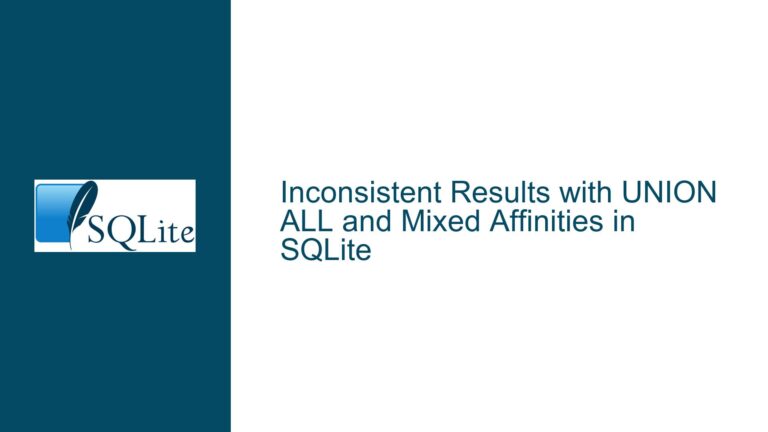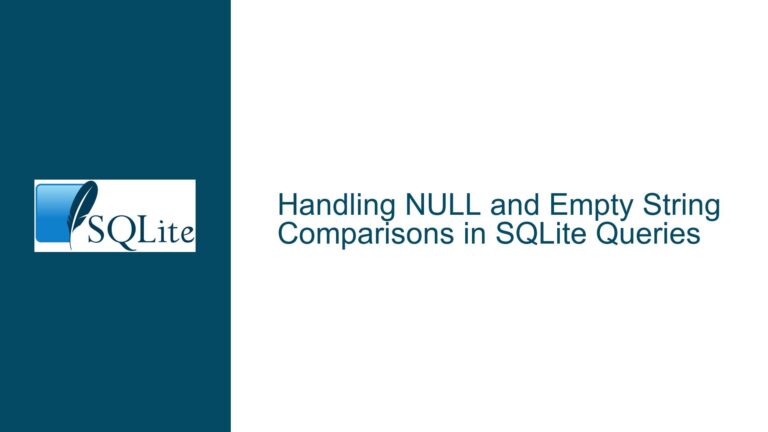Advanced String Formatting in SQLite: Challenges and Solutions
String Formatting Limitations in SQLite
SQLite, known for its lightweight and efficient design, has historically prioritized simplicity and minimalism in its feature set. While this approach has made SQLite a versatile and widely-used database engine, it also means that certain advanced functionalities, such as sophisticated string formatting, are not natively supported. The core issue at hand revolves around the limitations of SQLite’s string formatting capabilities, particularly when compared to more advanced string manipulation features found in programming languages like Python.
In SQLite, string concatenation and basic printf-style formatting are the primary tools available for constructing dynamic strings. The || operator is used for concatenation, and the format() function provides printf-style formatting. However, these methods fall short when users require more complex string formatting, such as placeholder-based interpolation or templating. For instance, Python’s str.format() method or f-strings allow for highly readable and flexible string construction using named placeholders, which is not directly achievable in SQLite.
The absence of advanced string formatting in SQLite can lead to verbose and less maintainable SQL queries, especially when dealing with dynamic content generation. This limitation becomes particularly evident when working with JSON data, where users might want to construct strings by interpolating values from JSON objects. While SQLite has made significant strides in JSON support with functions like json_object() and json_extract(), the lack of a native string formatting mechanism that integrates seamlessly with JSON data remains a notable gap.
Potential Causes of String Formatting Limitations
The primary cause of SQLite’s limited string formatting capabilities lies in its design philosophy. SQLite is engineered to be a self-contained, serverless, and zero-configuration database engine. This design prioritizes simplicity, portability, and minimal resource usage, which often means that advanced features are either omitted or implemented in a more basic form. The printf-style formatting provided by the format() function is a good example of this approach—it covers the most common use cases but does not extend to more complex scenarios.
Another contributing factor is the historical context of SQLite’s development. SQLite was initially designed to serve as an embedded database for applications that required lightweight data storage. In such contexts, advanced string formatting was often handled at the application level, reducing the need for complex string manipulation within the database itself. As SQLite’s use cases have expanded over time, the demand for more advanced features has grown, but the core design principles have remained largely unchanged.
Additionally, the lack of advanced string formatting in SQLite can be attributed to the challenges of implementing such features in a way that aligns with SQLite’s performance and size constraints. Advanced string formatting mechanisms, such as those found in Python, often require significant computational resources and complex parsing logic. Integrating these features into SQLite without compromising its performance or increasing its size is a non-trivial task.
Implementing Advanced String Formatting in SQLite
While SQLite does not natively support advanced string formatting, there are several approaches to achieve similar functionality. These solutions range from leveraging existing SQLite features to extending its capabilities through custom functions or external tools.
Using Concatenation and printf-Style Formatting
The most straightforward approach to string formatting in SQLite is to use the concatenation operator (||) and the format() function. These tools can be combined to construct dynamic strings, albeit in a more verbose manner compared to advanced formatting methods. For example, consider a table users with columns fname and age. A query to generate a formatted string using concatenation might look like this:
SELECT 'Hello ' || fname || ', you are ' || age || ' years old' AS greeting FROM users;
Alternatively, the format() function can be used to achieve a similar result with printf-style formatting:
SELECT format('Hello %s, you are %d years old', fname, age) AS greeting FROM users;
While these methods are effective for basic string formatting, they lack the flexibility and readability of more advanced approaches. For instance, they do not support named placeholders or direct integration with JSON data.
Leveraging JSON Functions for Dynamic String Construction
SQLite’s JSON functions can be used to enhance string formatting capabilities, particularly when working with JSON data. The json_object() function allows for the creation of JSON objects from column values, which can then be used to construct dynamic strings. For example:
CREATE TABLE users (
fname TEXT,
age INT,
formatter GENERATED ALWAYS AS (json_object('fname', fname, 'age', age))
);
INSERT INTO users VALUES ('Jane', 25);
SELECT 'Hello ' || json_extract(formatter, '$.fname') || ', you are ' || json_extract(formatter, '$.age') || ' years old' AS greeting FROM users;
This approach provides a way to dynamically construct strings using JSON data, but it still relies on concatenation and does not offer the same level of readability as advanced formatting methods.
Extending SQLite with Custom Functions
For users who require more advanced string formatting, extending SQLite with custom functions is a viable solution. This can be achieved by writing user-defined functions (UDFs) in a host language such as Python or C. These UDFs can then be registered with SQLite and used in queries to perform complex string formatting.
In Python, for example, a custom function can be created to leverage Python’s advanced string formatting capabilities. The following code demonstrates how to register a Python function with SQLite to perform string formatting using JSON data:
import sqlite3
import json
def pyfmt(fstr, jstr):
return fstr.format(**json.loads(jstr))
db = sqlite3.connect(':memory:', isolation_level=None)
db.execute("CREATE TABLE users (fname TEXT, age INT, formatter GENERATED ALWAYS AS (json_object('fname', fname, 'age', age)));")
db.execute("INSERT INTO users VALUES ('Jane', 25);")
db.create_function('pyfmt', 2, pyfmt)
for row in db.execute("SELECT pyfmt('Hello {fname}, you are {age} years old', formatter) FROM users;"):
print(row)
This approach allows for the use of Python’s advanced string formatting within SQLite queries, providing a high degree of flexibility and readability. However, it is important to note that this solution is language-specific and may not be suitable for all use cases.
For users who prefer to work with C, a similar approach can be taken by writing a loadable extension that provides advanced string formatting capabilities. This requires more effort but offers the advantage of being language-agnostic and potentially more performant.
Exploring External Tools and Libraries
In some cases, it may be more practical to handle advanced string formatting outside of SQLite, using external tools or libraries. For example, if SQLite is being used as part of a larger application, the application logic can be responsible for constructing dynamic strings based on data retrieved from the database. This approach allows for the use of the full range of string formatting features available in the host language, without the need to extend SQLite itself.
For instance, in a Python application, data retrieved from SQLite can be passed to Python’s str.format() method or f-strings for advanced formatting:
import sqlite3
db = sqlite3.connect(':memory:', isolation_level=None)
db.execute("CREATE TABLE users (fname TEXT, age INT);")
db.execute("INSERT INTO users VALUES ('Jane', 25);")
cursor = db.execute("SELECT fname, age FROM users;")
for row in cursor:
fname, age = row
print(f"Hello {fname}, you are {age} years old")
This approach decouples the string formatting logic from the database, allowing for greater flexibility and maintainability. However, it also means that the formatting logic is not encapsulated within the database, which may be a drawback in some scenarios.
Conclusion
While SQLite’s native string formatting capabilities are limited, there are several approaches to achieve more advanced string manipulation. By leveraging concatenation, printf-style formatting, JSON functions, custom functions, and external tools, users can overcome the limitations of SQLite’s built-in features. Each approach has its own trade-offs in terms of complexity, performance, and maintainability, and the best solution will depend on the specific requirements of the application.
For users who require advanced string formatting within SQLite, extending the database with custom functions or handling formatting at the application level are the most effective strategies. These approaches provide the flexibility and readability needed for complex string manipulation, while still leveraging SQLite’s core strengths as a lightweight and efficient database engine.






